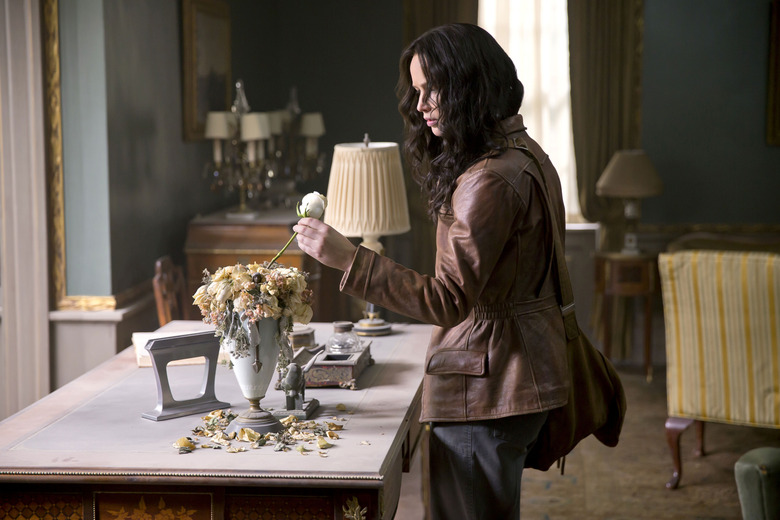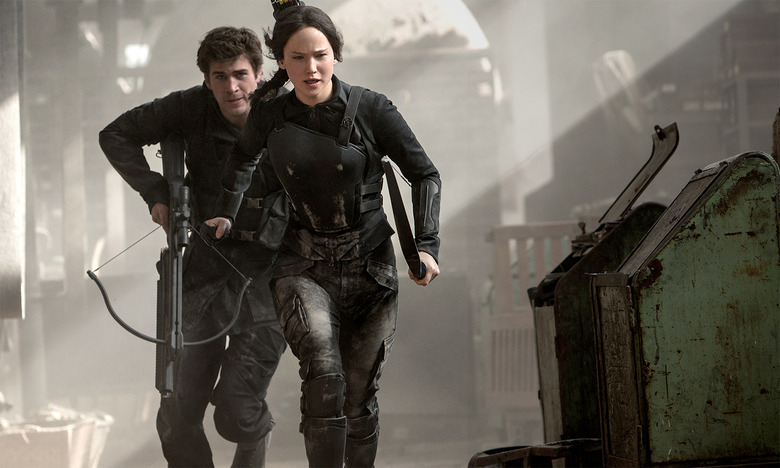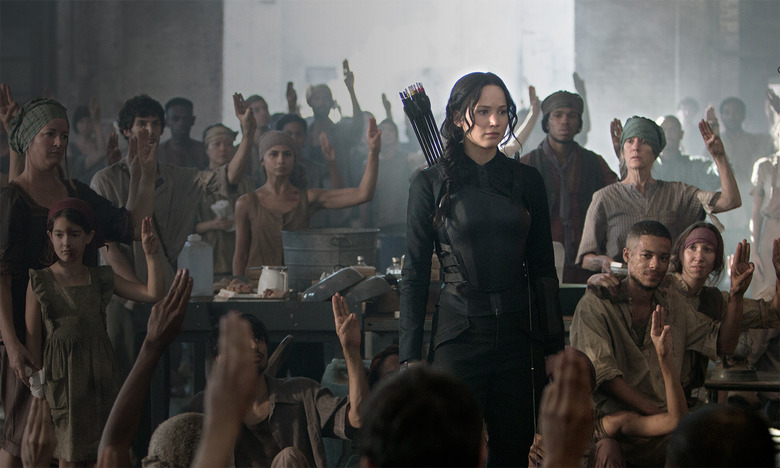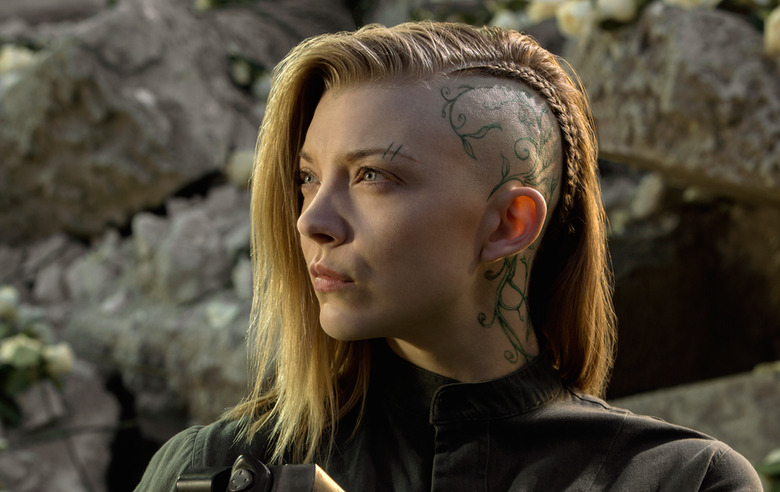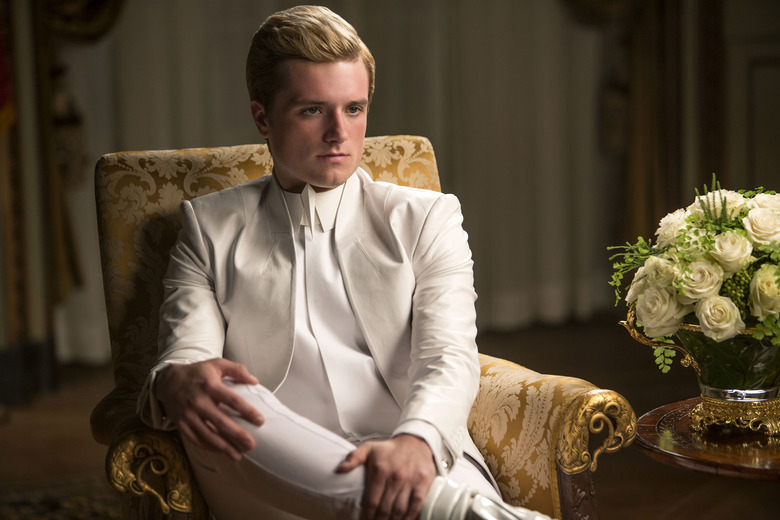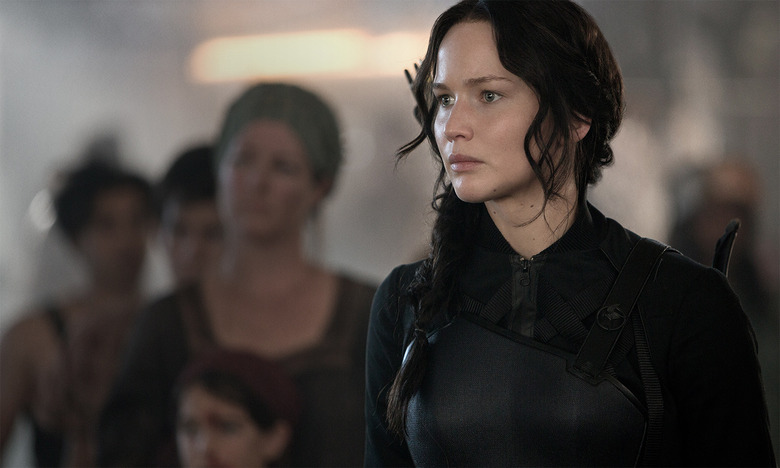Why 'The Hunger Games: Mockingjay Part 1' Feels Like A Different Franchise [Movie Review]
Note: This review was original published on November 10. We've bumped it up now that the film is in theaters.
It's a shame The Hunger Games series gets filed into the "young adult" category. Sure, there's some dystopian young romance in there, but with each subsequent film, the series proves it is about much more than unattainable love with sporadic action. The Hunger Games: Mockingjay Part 1 takes the series to its furthest point from YA stereotypes yet.
However, what's most interesting about this latest installment — the first part of a two-part finale — is just how different it is from the rest of the franchise. Is that a good thing? Below, read why The Hunger Games Mockingjay Part 1 feels like a different franchise.
The Hunger Games Are Gone
Though The Hunger Games: Mockingjay Part 1 has "Hunger Games" in the title, those days are gone. In the world of the film, The Games are a byproduct of the government in the Capital. By the time Mockingjay starts, the rebellion agains the Capitol has begun. The biggest problem within the film is that, by removing the clear narrative goal of games that must be survived, the story takes a little while to get going.
Mockingjay Part 1 picks up almost immediately after the end of the last film, Catching Fire. In that episode, we saw that friends of Katniss Everdeen (Jennifer Lawrence) had been using her to launch a rebellious action against President Snow (Donald Sutherland) and his overbearing Capital. Katniss' home has been destroyed and every one of her allies is hiding underground, waiting for their chance to fight. Everyone, that is, except Katniss' partner Peeta (Josh Hutcherson), who was left for dead.
As the film starts, Katniss is still very much reluctant to accept her role in this revolution. That reluctance is something she's been harboring for two movies now and director Francis Lawrence just drops us in the middle of it. There's no explanation, no preamble, no time to get reacclimated. The film waffles for 30 minutes, just like Katniss does. In that time, you might be worried about what this movie is going to be. For a while, no one really knows. At least with a Hunger Games event to move towards, there was a traditional, familiar narrative structure. This doesn't have that and while that's off-putting at the beginning of the film, it eventually evens out and the story even excels.
It's A Movie About War Propaganda
Once the film settles on what it's really about, it begins to shine. In place of The Hunger Games is an interesting rumination on media, public perception and war tactics. There's less action in this film than the others. Action is replaced with drama surrounding questions of how Katinss can help unite all the districts of Panem through propaganda. In a way, Mockingjay Part 1 is a movie about making movies.
Once Katniss decides to be the Mockingjay — the voice and face of the revolution — things pick up quick. We are reacquainted with many characters from the previous movies. Those played by the late Philip Seymour Hoffman, and Sam Claflin, Woody Harrelson, and Jeffrey Wright all have roles in the story. Elizabeth Banks, in particular, is a shot of adrenaline. Each actor is so comfortable in their roles and with each other by this time that they help the film begin to blossom. Also, the fact they now have a goal — get Katniss' image out into the public — helps the movie focus and drive the narrative forward. The movie really locks in and becomes a ride once it starts exploring the nature of this idea.
Subversive Ideas Replace the Fighting
So the movie is about telling the people of Panem that Katniss is alive and willing to fight with them. How does that story build momentum? A visit to a hospital in District 8 is the setting for one of the film's best scenes, in which a violent attack is flipped into an inspiring piece of video footage. A simple moment of quiet between Katniss and her friends is turned into a nationwide battle cry. These scenes start small but are twisted into meaningful propaganda against the Capitol.
In fact, much of the plot of the film unfolds on video monitors, or through interviews, showing how information is carefully packed and delivered in this world. Reactions to that information are instantaneous and without context. Those reactions lead to further results which are sometimes irrational and irreversible. These ideas transcend the YA stereotype, and The Hunger Games: Mockingjay Part 1 keeps things fresh. You never quite know how what you're seeing will play out.
New Characters Are Very Important
With Peeta out of commission and Katniss attempting to inspire a nation, many of the main characters from the previous two films take a back seat. Others come to the foreground. Gale (Liam Hemsworth) finally has stuff to do; President Coin (Julianne Moore) is a new, powerful addition; and Cressida (Natalie Dormer) is really exciting. The fact that after two movies, we can still meet and enjoy new characters gives the film a life and separation that's welcome in a sequel.
In particular, Cressida sums up what's so different about The Hunger Games: Mockingjay Part 1. She's not a warrior or killer. She's a film director, escaped from the Capitol and hired by the rebellion to craft a heroic image for Katinss. Along with her film crew, Cressida is in all of the most powerful scenes in the film and, in fact, is tangentially responsible for their creation. She's the movie in a nutshell — brutal and seemingly predictable on the outside, but much deeper and more interesting than a superficial reading allows.
The Film Feels Like Only Part of a Whole
By their very nature, each of The Hunger Games movies end on a bit of a cliffhanger. There's always more story to tell. However, with the first two films, those stories at least had a conclusion before tagging on a tease. There's a lot of good stuff in Mockingjay Part 1, but far more than the other films, it feels like an incomplete story.
The conclusion works as a set piece, combining several moving pieces into a great climactic moment, but it's only partially satisfying. After two hours of set up, one major story point is settled. You quickly realize you're watching the first half of a four-hour movie. Then again, "Part 1" is in the title. This was an issue that was likely to plague the movie no matter what. Nevertheless, you can't help but think a little less of the movie when it sets up such good stuff that won't pay off for another year.
The Verdict
Who would have thought The Hunger Games: Mockingjay Part 1 would have more in common with the Fredrick Zoller story in Inglorious Basterds than the first two Hunger Games? It's a very welcome surprise and really gives the film a lot of cool directions to go in. The rough beginning and slightly disappointing ending do hurt the film a bit but never the less, the middle builds crazy momentum and earns huge points for aspiring to be something more. In the end, the fact millions of kids are going to watch a movie about the role of media is so crazy you have to give it credit.
/Film Rating: 7.5 out of 10

